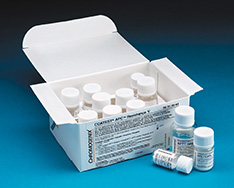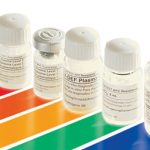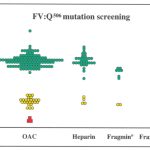
Chromogenix Coatest® APC™ Resistance – V
$0.00
Chromogenix Coatest® APC™ Resistance – V is an APTT-based assay kit for the screening of factor-V-related APC resistance. The high sensitivity and specificity of the test for the factor V:Q506 mutation is obtained by prediluting the sample plasma with an excess of V-DEF Plasma bioreagent. The test design makes it possible to discriminate between heterozygous and homozygous factor V genotypes. It also allows for analysis of plasma from patients on heparin or oral anticoagulant therapy. High discrimination between genotypes with 100% sensitivity for FV:Q506. Reduces need for PCR determination. Applicable to anticoagulant treated patients.
A time- and money-saving alternative to individual genetic testing, Coatest© APC™ Resistance testing is an ideal solution for physicians and labs. Each kit was designed to be easy to use for in-house screening, offering fast results and low costs for both large- and small-volume labs. The most common FV Leiden screening test performed, it offers unmatched sensitivity for the FV:Q506 mutation – close to 100% specificity – and is applicable to patients on heparin or warfarin.
Measurement Principle
One volume of plasma is prediluted with four volumes of V-DEF Plasma. The dilution is then incubated with the APTT reagent for a standard period of time. Coagulation is triggered by the addition of CaCl2 in the absence and presence of exogenous APC and the time for clot formation is recorded.
Activated Protein C (APC) is a regulator of the coagulation cascade, by specifically inactivating factors Va and VIIIa, in the presence of phospholipids and calcium. In most of the cases (more than 90%), Activated Protein C Resistance (APCR) phenotype is caused by a Factor V gene mutation (Factor V Leiden). The mutation, located on Factor V exon 10 (1691 G –> A), of arginine to glutamine on position 506, renders Factor Va resistant to the cleavage by Activated Protein C. This genetic anomaly can be evidenced with a clotting method performed in the presence or the absence of Activated Protein C.
Reagents and their stability when opened
| Reagent | Size | Stability | Temp |
|---|---|---|---|
| APC/CaCl2 | 4×2 ml | 8 hours 5 days 3 months |
15-25°C 2-8°C -20°C |
| APTT reagent | 1×16 ml | 1 week 1 month |
15-25°C 2-8°C |
| CaCl2 | 1×8 ml | 1 week 1 month |
15-25°C 2-8°C |
| V-DEF Plasma | 4×4 ml | 8 hours 24 hours 3 months |
15-25°C 2-8°C -20°C |
| Control Plasma Level 1 | 1×1 ml | 6 hours 3 months |
2-25°C -20°C |
| Control Plasma Level 2 | 1×1 ml | 6 hours 3 months |
2-25°C -20°C |
Determinations per kit: 80-160
Downloads
- Package Insert (PDF)
- Safety Data Sheet (PDF)
- CofA - Lot(s): N0844861 - Exp: 01/31/2026 (PDF)
- CofA - Exp: 01/30/2026 (PDF)
- CofA - Exp: 01/31/2026 (PDF)
- CofA - Exp: 09/30/2026 (PDF)
- CofA - Exp: 09/30/2026 (PDF)
- CofA - Exp: 09/30/2026 (PDF)
- CofA - Exp: 09/30/2026 (PDF)
- Brochure (PDF)
- Tech Tips (PDF)
- Short Presentation (PDF)
- Long Presentation (PDF)
What is the interaction between Protein S and APC?
Only the free, native form of PS binds to APC and functions as a cofactor. PS has the highest affinity for negatively charged phospholipids of all the vitamin K-dependent proteins and has been shown to increase by approximately 10-fold, the affinity of APC for membranes or vesicles containing such phospholipids. This may be of physiological importance since APC degrades preferentially membrane-bound FVa and FVIIIa, but not the circulating, inactivated co-factors. In addition to increasing the affinity of APC to membranes, PS also enhances the cleavage of FVa by APC and works in concert with FV to increase the ability of APC to inactivate FVIIIa.
Explain the types of protein C deficiency, and the clinical manifestations.
Hereditary protein C deficiency is inherited as an autosomal dominant trait. Heterozygotes for protein C deficiency have protein C activity or antigen levels of 30-70% normal, whereas homozygotes with a severe defect have levels below 1%. The prevalence of protein C deficiency is 2-5% in patients with thromboembolic disease. Two types of protein C deficiency states are recognized. In type I deficiency, which is the most common type of disorder, the plasma concentration of protein C is reduced both in functional and immunological assays. This reflects a genetic defect causing a reduced biosynthesis of protein C. Type II deficiency is characterized by normal protein C antigen levels, but with decreased functional activity. This type of defect reflects synthesis of abnormal molecules with reduced function. The most common clinical manifestation of symptomatic heterozygous protein C deficiency is deep vein thrombosis (DVT) of the lower extremities. Patients with homozygous protein C deficiency usually suffer from severe and fatal thrombosis in the early stage of life.
Protein C deficiency can also be acquired. Protein C level is influenced by various diseases and drugs such as DIC, DVT, liver disease, sepsis, oral anticoagulant therapy, and surgery.
In contrast, elevated Protein C levels have been reported in such cases as diabetic patients and with the use of anabolic steroids and oral contraceptives. Elevated levels of protein C have no known clinical significance.
Which assay should I run Chromogenix Coatest® APC Resistance or Coatest® APC Resistance V?
During the last years recent publication have been showing that the APC Resistance phenotype is a risk factor for venous thrombosis, irrespective of the FV Leiden mutation, and hence this illustrates that the Coatest® APC Resistance and the Coatest® APC Resistance V kits measure different entities. For this reason, both Coatest® APC Resistance and the Coatest® APC Resistance V kits are included in the thrombophilia screening panel in some important laboratories. A recent and interesting publication on inherited thrombophilia was done by Uri Seligsohn and Aharon Lubetsky. In this paper, both APCR and APCR V are suggested as part of six high priority tests. The diagnosis for factor V Leiden should be confirmed by genetic test, in order to decide whether the family members should be examined.
What is the normal baseline range for the APTT reaction? What types of conditions might cause a patient to give abnormal aPT time, and what can be done about it?
The normal range is approximately 25-40 seconds, although it will vary slightly depending on instrument. Although the 1:4 dilution with V deficient plasma strongly decreases interferences from oral anticoagulants and heparin therapy, it cannot be excluded that analysis from patients with high inhibitor activity such as those with phospholipid antibodies (i.e. lupus anticoagulant) may give an abnormal APTT. Increasing the dilution factor to 1:9 or 1:19 may correct the results. According to a study by Nowak et al, a 1:10 dilution may also be useful in children less than one year old. This is due to the special properties of the neonatal hemostatic system, such as low vitamin-K dependent coagulation factors and physiological prolongation of the PT and APTT.
What effect does variation of plasma levels of protein C have on the APC ratio?
Variations in plasma levels of protein C have no influence on the APC ratio since a standardized amount of exogenous APC is added.
How do factor V and VIII levels affect the Chromogenix Coatest® APC Resistance tests?
A study by Colucci et al. (Thromb. Haemost. 1994, 72:987 – 988) using the classical APTT method (no FV-deficient plasma pre-dilution) showed that changes in FV levels between 12.5-100% did not modify the response to APC. Other experience has shown that the Coatest® APC Resistance V test may provide ratio values approximately 0.3 units below the median level, which can be fairly close to the cut-off value, when FV levels are 0-40%. This may be explained by the fact that although there is often no abnormal bleeding tendency in heterzygotes with factor V deficiency, prolonged PT and APTT times are observed (ref: Sartori et al. Familial association of hypoplasminogenemia and heterozygous factor V deficiency. Clin Appl Thromb Hemost. 1999; 5(4): 277-281; Salooja N et al. Severe factor V deficiency and neonatal intracranial haemorrhage: a case report. Haemophilia. 2000; 6(1): 44-46. One might also see a slightly decreased ratio in patients with severe liver disease.
According to Chromogenix, FVIII samples above 1.8 IU/ml may result in a reduction of the APC ratio of approximately 0.2 units, although the actual correlation between FVIII activity and APC ratio appears to be weak. When sampling, therefore, the patient should be at rest in order to decrease the FVIII level due to stress.
Can I freeze the reagents in the Chromogenix Coatest® APC Resistance kits to prolong their stability?
The APTT reagent cannot be frozen. The other reagents can, but should be rapidly thawed at 37°C and cannot be re-frozen.
How do Protein S and APC interact?
Only the free, native form of PS binds to APC and functions as a cofactor. PS has the highest affinity for negatively charged phospholipids of all the vitamin K-dependent proteins and has been shown to increase by approximately 10-fold, the affinity of APC for membranes or vesicles containing such phospholipids. This may be of physiological importance since APC degrades preferentially membrane-bound FVa and FVIIIa, but not the circulating, inactivated co-factors. In addition to increasing the affinity of APC to membranes, PS also enhances the cleavage of FVa by APC and works in concert with FV to increase the ability of APC to inactivate FVIIIa.
Describe the protein C pathway and APC resistance. What is the relative risk of venous thrombosis for those who are APC resistant?
Protein C is a vitamin-K-dependent glycoprotein and plasma proenzyme of a serine protease that plays a key role in the down-regulation of blood coagulation. It is activated in vivo by the thrombin-thrombomodulin complex on the surface of intact endothelial cells. Activated protein C (APC) functions as a circulating anticoagulant through proteolytic cleavage and inactivation of the coagulation factors Va and VIIIa. The cleavage occurs at three sites in the heavy chain of each protein. The anticoagulant activity of APC is potentiated by the free form of Protein S (about 60% of PS in plasma is bound to C4bBP, and 40% is in free form) and FV. APC Resistance is actually due to a defect in the protein C pathway, in the factor V molecule as opposed to the activated protein C molecule. APC Resistance is an autosomal dominant hereditary defect mainly due to a point mutation resulting in an amino acid change in the FV gene (Ag506 to Gln mutation, or Factor V Leiden mutation). The mutation destroys one of the three cleavage sites, rendering FVa partially resistant to APC-mediated degradation. APC resistance occurs in 3-5% of the general population, but varies largely in different parts of the world. Up to 90% of APC resistance cases are due to the Factor V:Q506 gene mutation. The relative risk of DVT for carriers of the FV:Q506 mutation is estimated to be 8-fold for heterozygotes and 80-fold for homozygotes.
Background
Activated Protein C (APC) is a regulator of the coagulation cascade, by specifically inactivating factors Va and VIIIa, in the presence of phospholipids and calcium.
In most of the cases (more than 90%), Activated Protein C Resistance (APCR) phenotype is caused by a Factor V gene mutation (Factor V Leiden). The mutation, located on Factor V exon 10 (1691 G –> A), of arginine to glutamine on position 506, renders Factor Va resistant to the cleavage by Activated Protein C. This genetic anomaly can be evidenced with a clotting method performed in the presence or the absence of Activated Protein C.
Activated Protein C Resistance is tested by using a clotting method performed with or without Activated Protein C.
Learn more about APC and Factor V Leiden
Factor V Leiden Testing Algorithm
Ideal for:
- Labs looking to bring testing in-house
- Labs looking for cost savings
- Ordering physicians looking for a sensitive assay with rapid turnaround
- Saves the lab from having to perform genetic test on all patients
- Economical alternative to genetic testing


